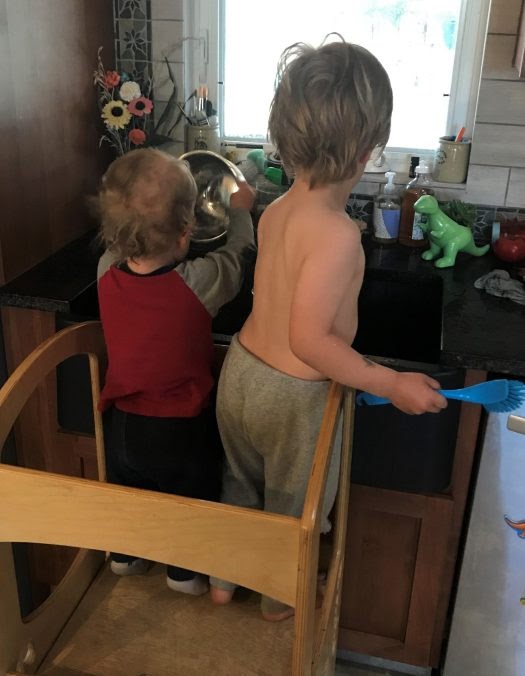Practical life activities and works are a critical part of each Montessori classroom at every age level. Practical life works can include things like sweeping, washing dishes, plant care, folding laundry, gardening, pet care, shoveling snow, cooking, dusting, sewing, etc. Most of us know these activities as the “chores” we had to do as kids. In a Montessori environment, those works allow children to actively participate in the “work of the home”, or Montessori-style “homework”. Practical life activities not only teach children how to perform necessary tasks of running a household, but also critical skills like eye-hand coordination, fine motor skills development, organization, planning, concentration, task-completion, pride in oneself, responsibility, and independence. As parents, I think most of us would agree that having our children learn and practice those skills is critical to their development as responsible citizens.
Remote learning time should include not only academic pursuits but also incorporate those practical life skills tasks. One way to help children come to a place of focus for deeply academic tasks is to have the child perform a practical life activity before, or after the academic work. This allows the child’s brain and body to move and think in ways that prepare for, or rest from more cerebral works. Often in a Montessori classroom, you will see students engaged in various practical life works throughout the day for this very reason. Be sure to include practical life works in your child’s remote learning day. Below, I will list a variety of practical life works that can be accomplished at each age level.
Practical Life activities for children ages 1-3:
- picking up toys or other objects and putting them in a basket
- wiping up a spill
- hand washing
- brushing hair/teeth
- putting sliced cheese on crackers
- digging a hole in the garden
- turning light switches off/on
- taking dishes to the kitchen after mealtime
Practical Life activities for children ages 3-6:
- cutting up soft foods for a snack (bananas, cheese, etc.)
- washing dishes
- sweeping up a mess
- washing windows
- folding towels
- putting library books in the return slot
- setting silverware and napkins on the table
- spraying plants with a water mister
Practical Life activities for children ages 6-9:
- flower arranging
- feeding and grooming pets
- making the grocery list (and crossing items off while shopping)
- helping plan and prepare a meal
- writing and mailing a letter to someone
- simple sewing/crafting projects
- planting seeds/harvesting in the garden
- raking leaves into piles
Practical Life activities for children ages 9-12:
- woodworking projects
- helping to plan a weekend family get-away
- helping care for younger siblings
- starting and contributing to a blog/ YouTube channel
- meal planning/preparation
- hosting a yard sale
- house-cleaning work
- washing the car
As you can see, there are any number of activities that kids of all ages can do to help out with household tasks that would be considered practical life works. The skills that are learned and practiced while engaging in practical life activities will serve children, not only in the immediate situation of “stay-at-home” orders during the pandemic, but also beyond into their own adult lives. Children who participate in the “work of the home” feel a sense of accomplishment, pride and importance to the family unit that is at least as important, if not more so, than the actual tasks themselves. If your family doesn’t already have a plan for each member of the family contributing by doing practical life tasks, I say schedule a family meeting-soon- and come up with a plan to help everyone be and feel involved in the running of your household. It will serve each of you, and the family as a whole very well!


